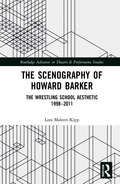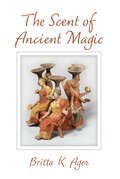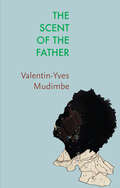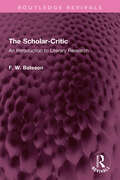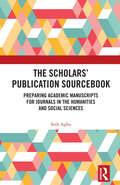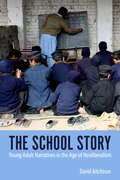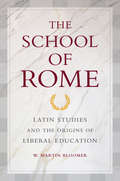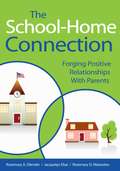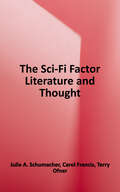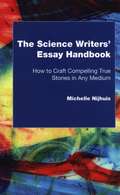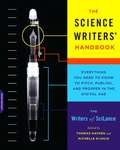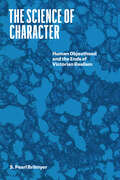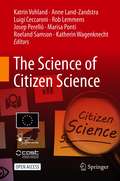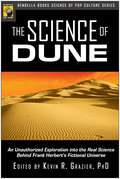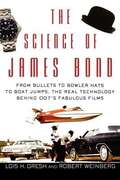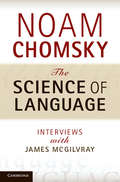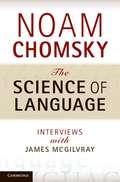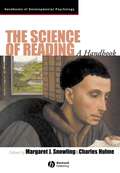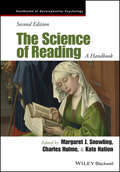- Table View
- List View
The Scene of the Voice: Thinking Language after Affect (SUNY series in Contemporary Continental Philosophy)
by Michael EngThe recent turns to affect and aesthetics in the humanities and the interpretive social sciences have been productive for reflecting on the crucial role sensibility plays in the constitution of the social. However, these scholarly developments construct their interventions by dismissing the attention to language that was central to the linguistic and cultural turns of previous eras and by claiming that language is an obstacle to experiencing the reality of difference to which they maintain only sensibility can grant access. By analyzing the figure of the voice in the work of Martin Heidegger and the continental thinkers who follow him, The Scene of the Voice shows that the dismissal of language in favor of sensibility requires overlooking their common connection in the problem of mimesis. As this book ultimately argues, artificially separating language and sensibility results in a failure to encounter affect, the relation to difference affect is said to name, and the experience of thinking affect is taken to provoke.
The Scenography of Howard Barker: The Wrestling School Aesthetic 1998-2011 (Routledge Advances in Theatre & Performance Studies)
by Lara Maleen KippInfluential contemporary British playwright and director Howard Barker has been engaging with the scenography of the Wrestling School’s productions since 1998. Despite this active involvement in the design of set, costume, lighting, and sound, no in-depth published study on this aspect of his work exists to date. This monograph therefore offers the first comprehensive and detailed analysis of Barker’s scenographic practice. Combining aesthetic analysis of play texts and production records with original interview materials, this book presents the first full-length foray into Barker’s scenography. It features extracts from conversations with designers working with Barker, and with Barker himself. In addition, it presents the first printed versions of select set and costume designs by Barker. With the first fully detailed analysis of Barker’s scenographic work, this book will be a vital read for scholars and postgraduates of Barker Studies, contemporary British and European drama, theatre, and scenography.
The Scent of Ancient Magic
by Britta K. AgerMagic was a fundamental part of the Greco-Roman world. Curses, erotic spells, healing charms, divination, and other supernatural methods of trying to change the universe were everyday methods of coping with the difficulties of life in antiquity. While ancient magic is most often studied through texts like surviving Greco-Egyptian spellbooks and artifacts like lead curse tablets, for a Greek or Roman magician a ritual was a rich sensual experience full of unusual tastes, smells, textures, and sounds, bright colors, and sensations like fasting and sleeplessness. Greco-Roman magical rituals were particularly dominated by the sense of smell, both fragrant smells and foul odors. Ritual practitioners surrounded themselves with clouds of fragrant incense and perfume to create a sweet and inviting atmosphere for contact with the divine and to alter their own perceptions; they also used odors as an instrumental weapon to attack enemies and command the gods. Elsewhere, odiferous herbs were used equally as medical cures and magical ingredients. In literature, scent and magic became intertwined as metaphors, with fragrant spells representing the dangers of sensual perfumes and conversely, smells acting as a visceral way of envisioning the mysterious action of magic. The Scent of Ancient Magic explores the complex interconnection of scent and magic in the Greco-Roman world between 800 BCE and CE 600, drawing on ancient literature and the modern study of the senses to examine the sensory depth and richness of ancient magic. Author Britta K. Ager looks at how ancient magicians used scents as part of their spells, to put themselves in the right mindset for an encounter with a god or to attack their enemies through scent. Ager also examines the magicians who appear in ancient fiction, like Medea and Circe, and the more metaphorical ways in which their spells are confused with perfumes and herbs. This book brings together recent scholarship on ancient magic from classical studies and on scent from the interdisciplinary field of sensory studies in order to examine how practicing ancient magicians used scents for ritual purposes, how scent and magic were conceptually related in ancient literature and culture, and how the assumption that strong scents convey powerful effects of various sorts was also found in related areas like ancient medical practices and normative religious ritual.
The Scent of the Father: Essay on the Limits of Life and Science in sub-Saharan Africa (Critical South)
by Valentin-Yves MudimbeValentin-Yves Mudimbe is a Congolese philosopher, novelist, poet, essayist, and academic, widely considered to be one of the most important African thinkers of his generation. The ideas and arguments he has developed in his writings since the 1970s, including The Invention of Africa, have been hugely influential across many disciplines and established his reputation as one of the essential postcolonial thinkers of our time. In The Scent of the Father, Mudimbe set himself the task of shedding light on the complex links that bind Africa to the West and determine the exercise of thought and knowledge practices, particularly in relation to the social sciences. For Africa to escape the West, says Mudimbe, it must become aware of what remains Western in the very concepts and forms of thought that allow it to think against the West, and be alert to the possibility that the recourse against the West might be just another ruse that the West uses for its own ends. Africa must elucidate the modalities of the integration of Africans into the myths of the West, while at the same time aiming at the readaptation of the African psyche in the wake of the violence it has suffered. This seminal work by a leading African thinker will be of great interest to anyone concerned with the legacies of colonialism and the debates on decolonization and decoloniality in the social and human sciences.
The Schocken Book of Modern Sephardic Literature
by Ilan StavansThe expulsion of the Jews from Spain in 1492 gave rise to a series of rich, diverse diasporas that were interconnected through a common vision andjoie de vivre. The exodus took these Sephardim to other European countries; to North Africa, Asia Minor, and South America; and, eventually, to the American colonies. In each community new literary and artistic forms grew out of the melding of their Judeo-Spanish legacy with the cultures of their host countries, and that process has continued to the present d...
The Scholar-Critic: An Introduction to Literary Research (Routledge Revivals)
by F. W. BatesonFirst Published in 1972, The Scholar-Critic argues that it's a mistake to consider literary criticism and literary scholarship as each other 's antitheses. The two approaches to literature are, except at the most superficial level, complementary, both indispensable, both equally honourable aspects of a single discipline. The book deals with themes like the sense of fact; works of reference; the literary object; style and interpretation; textual criticism and literary history; and presentation. This is an interesting read for scholars and researchers of English literature.
The Scholars’ Publication Sourcebook: Preparing Academic Manuscripts for Journals in the Humanities and Social Sciences
by Seth AgboThis book is a comprehensive guide for instructors and graduate students on preparing scholarly manuscripts for peer-reviewed journals, theses, or dissertations in the humanities and social sciences.Providing a toolbox of approaches to understand the structures around manuscript preparation, it offers an in-depth understanding of the different types of manuscripts and the nuanced approaches required. It illuminates each stage of the process, from the initial identification of a topic to the publication of the final article. It draws on the expertise of various contributors, including journal editors, editorial board members, peer reviewers, and research methods instructors. The book is a practical guide for all instructors and students seeking insight into the publishing process in high-impact journals. It draws from case studies across various fields such as sociology, psychology, political science, business studies, policy research, and public health.The book will be of particular relevance to early-career scholars, graduate students, and instructors working with students preparing theses, dissertations, or journal articles. It serves as a valuable resource for understanding and navigating the complex world of academic publishing.
The School Story: Young Adult Narratives in the Age of Neoliberalism (Children's Literature Association Series)
by David AitchisonThe School Story: Young Adult Narratives in the Age of Neoliberalism examines the work of contemporary writers, filmmakers, and critics who, reflecting on the realm of school experience, help to shape dominant ideas of school. The creations discussed are mostly stories for children and young adults. David Aitchison looks at serious novels for teens including Laurie Halse Anderson’s Speak and Faiza Guène’s Kiffe Kiffe Tomorrow, the light-hearted, middle-grade fiction of Andrew Clements and Tommy Greenwald, and Malala Yousafzai’s autobiography for young readers, I Am Malala. He also responds to stories that take young people as their primary subjects in such novels as Sapphire’s Push and films including Battle Royale and Cooties. Though ranging widely in their accounts of young life, such stories betray a mounting sense of crisis in education around the world, especially in terms of equity (the extent to which students from diverse backgrounds have fair chances of receiving quality education) and empowerment (the extent to which diverse students are encouraged to gain strength, confidence, and selfhood as learners). Drawing particular attention to the influence of neoliberal initiatives on school experience, this book considers what it means when learning and success are measured more and more by entrepreneurship, competitive individualism, and marketplace gains. Attentive to the ways in which power structures, institutional routines, school spaces, and social relations operate in the contemporary school story, The School Story offers provocative insights into a genre that speaks profoundly to the increasingly precarious position of education in the twenty-first century.
The School of Cyrus: William Barker's 1567 Translation of Xenophon's Cryopaedeia (Routledge Revivals)
by James TatumOriginally published in 1987, this book is a translation of Xenophon's Cyropaedeia (The Education of Cyprus), first published in 1567.
The School of Rome: Latin Studies and the Origins of Liberal Education
by W. Martin BloomerThis fascinating cultural and intellectual history focuses on education as practiced by the imperial age Romans, looking at what they considered the value of education and its effect on children. W. Martin Bloomer details the processes, exercises, claims, and contexts of liberal education from the late first century BCE to the third century CE--the epoch of rhetorical education. He examines the adaptation of Greek institutions, methods, and texts by the Romans, and traces the Romans' own history of education. Bloomer argues that while Rome's enduring educational legacy includes the seven liberal arts and a canon of school texts, its practice of competitive displays of reading, writing, and reciting were intended to instill in the young social as well as intellectual ideas.
The School-Home Connection: Forging Positive Relationships with Parents
by Rosemary A. Olender Jacquelyn Elias Rosemary D. MastroleoResearch has consistently shown that student success is directly related to the strength of the relationships between parents and schools. In The School-Home Connection, the authors draw on original research and their professional experiences to identify the common sources of both negative and positive school-home relationships. The book presents a comprehensive approach to building closer connections and includes:Tools to help educators develop a deeper understanding of the communities they serveStrategies for improving interpersonal skills and communication skillsA chapter on the importance of documenting and celebrating school eventsGuidelines for creating three distinct levels of parental participation in schoolsWith suggestions for cultivating a community network of support services and a summary of lessons for forging constructive relationships, The School-Home Connection is an essential tool for educators looking to strengthen the learning community and increase student achievement.
The Sci-Fi Factor (Literature and Thought)
by Terry OfnerTeaches critical thinking and focuses on the question "What's the fascination with science fiction?" with selections by Ray Bradbury, Isaac Asimov, Ursula K. Le Guin, Fredric Brown, Paul Jennings, Carol Farley, and more. Literature & Thought Series.
The Science Writers' Essay Handbook: How To Craft Compelling True Stories In Any Medium
by Michelle NijhuisThough the essay form is more than four centuries old, it's perfectly suited to the digital age--and to science writing. The Science Writers' Essay Handbook will show you how to: <p><p>* Recognize and develop essay ideas * Research and report for the essay form <p>* Organize your material before you write<p> * Develop a distinctive authorial voice <p>* Revise and polish your essays for publication <p>* Apply your essay-writing skills to stories of all kinds, from magazine features to multimedia productions to social-media posts <p> No matter what kind of science storyteller you are, The Science Writers' Essay Handbook will give you new tools to bring out the best in your work.
The Science Writers' Handbook: Everything You Need to Know to Pitch, Publish, and Prosper in the Digital Age
by Thomas Hayden Michelle NijhuisPopular science writing has exploded in the past decade, both in print and online. Who better to guide writers striving to succeed in the profession than a group of award-winning independent journalists with a combined total of 225 years of experience? <P><P>From Thomas Hayden’s chapter on the perfect pitch to Emma Maris’s advice on book proposals to Mark Schrope’s essential information on contracts, the members of SciLance give writers of all experience levels the practical information they need to succeed, as either a staffer or a freelancer. Going beyond craft, The Science Writer’s Handbook also tackles issues such as creating productive office space, balancing work and family, and finding lasting career satisfaction. It is the ultimate guide for anyone looking to prosper as a science writer in the new era of publishing.
The Science of Character: Human Objecthood and the Ends of Victorian Realism (Thinking Literature Ser.)
by S. Pearl BrilmyerThe Science of Character makes a bold new claim for the power of the literary by showing how Victorian novelists used fiction to theorize how character forms. In 1843, the Victorian philosopher John Stuart Mill called for the establishment of a new science, “the science of the formation of character.” Although Mill’s proposal failed as scientific practice, S. Pearl Brilmyer maintains that it found its true home in realist fiction of the period, which employed the literary figure of character to investigate the nature of embodied experience. Bringing to life Mill’s unrealized dream of a science of character, novelists such as George Eliot, Thomas Hardy, and Olive Schreiner turned to narrative to explore how traits and behaviors in organisms emerge and develop, and how aesthetic features—shapes, colors, and gestures—come to take on cultural meaning through certain categories, such as race and sex. Engaged with materialist science and philosophy, these authors transformed character from the liberal notion of the inner truth of an individual into a materially determined figuration produced through shifts in the boundaries between the body’s inside and outside. In their hands, Brilmyer argues, literature became a science, not in the sense that its claims were falsifiable or even systematically articulated, but in its commitment to uncovering, through a fictional staging of realistic events, the laws governing physical and affective life. The Science of Character redraws late Victorian literary history to show how women and feminist novelists pushed realism to its aesthetic and philosophical limits in the crucial span between 1870 and 1920.
The Science of Citizen Science
by Roeland Samson Katrin Vohland Anne Land-Zandstra Luigi Ceccaroni Rob Lemmens Josep Perelló Marisa Ponti Katherin WagenknechtThis open access book discusses how the involvement of citizens into scientific endeavors is expected to contribute to solve the big challenges of our time, such as climate change and the loss of biodiversity, growing inequalities within and between societies, and the sustainability turn. The field of citizen science has been growing in recent decades. Many different stakeholders from scientists to citizens and from policy makers to environmental organisations have been involved in its practice. In addition, many scientists also study citizen science as a research approach and as a way for science and society to interact and collaborate. This book provides a representation of the practices as well as scientific and societal outcomes in different disciplines. It reflects the contribution of citizen science to societal development, education, or innovation and provides and overview of the field of actors as well as on tools and guidelines. It serves as an introduction for anyone who wants to get involved in and learn more about the science of citizen science.
The Science of Dune: An Unauthorized Exploration into the Real Science Behind Frank Herbert's Fictional Universe
by Kevin R. GrazierGet excited for the 2021 Denis Villeneuve Dune film release, starring Timothée Chalamet, with The Science of Dune! Since its original publication in 1965, the Dune series has entranced generations of readers with its complex plotting, fascinating characters, grand scope, and incredible scientific predictions. This guide offers fascinating scientific speculation on topics including quantum physics, biochemistry, ecology, evolution, psychology, technology, and genetics. It scrutinizes Frank Herbert&’s science fiction world by asking questions such as: Is the ecology of Dune realistic? Is it theoretically possible to get information from the future? Could humans really evolve as Herbert suggests? Which of Herbert&’s inventions have already come to life? This companion is a must-have for any fan who wants to revisit the world of Dune and explore it even further.
The Science of Harry Potter
by Roger HighfieldCan Fluffy the three-headed dog be explained by advances in molecular biology? Could the discovery of cosmic "gravity-shielding effects" unlock the secret to the Nimbus 2000 broomstick's ability to fly? Is the griffin really none other than the dinosaur Protoceratops? Roger Highfield, author of the critically acclaimed The Physics of Christmas, explores the fascinating links between magic and science to reveal that much of what strikes us as supremely strange in the Potter books can actually be explained by the conjurings of the scientific mind. This is the perfect guide for parents who want to teach their children science through their favorite adventures as well as for the millions of adult fans of the series intrigued by its marvels and mysteries.
The Science of James Bond: From Bullets to Bowler Hats to Boat Jumps, the Real Technology Behind 007's Fabulous Films
by Lois H. Gresh Robert WeinbergThe science behind the gadgets, exploits, and enemies of the world's greatest spy. From the sleek Aston Martin that spits out bullets, nails, and passengers at the push of a button to the microjet that makes hairpin turns to avoid a heat-seeking missile, the science and technology of James Bond films have kept millions of movie fans guessing for decades. Are these amazing feats and gadgets truly possible? The Science of James Bond takes you on a fascinating excursion through the true science that underlies Bond's most fantastic and off-the-wall accoutrements. The acclaimed science-fiction authors Lois Gresh and Robert Weinberg provide a highly entertaining, informative look at the real-world achievements and brilliant imaginations behind such singular Bond gadgets as the buzz-saw Rolex, the car that turns into a submarine, and the ever-popular rocket-firing cigarette. They examine hundreds of Q Division's ingenious inventions; analyze Bond's astonishing battles beneath the earth and sea, in the skies, and even in outer space; and ask intriguing questions that lead to enlightening discussions about the limits of science, the laws of nature, and the future of technology. Filled with entertaining anecdotes from Bond movie shoots and supplemented with "tech" ratings for all of the Bond movies, The Science of James Bond separates scientific fact from film fantasy--with some very surprising results.
The Science of Language
by Noam Chomsky James McgilvrayNoam Chomsky is one of the most influential thinkers of our time, yet his views are often misunderstood. In this previously unpublished series of interviews, Chomsky discusses his iconoclastic and important ideas concerning language, human nature and politics. In dialogue with James McGilvray, Professor of Philosophy at McGill University, Chomsky takes up a wide variety of topics Ai the nature of language, the philosophies of language and mind, morality and universality, science and common sense, and the evolution of language. McGilvray's extensive commentary helps make this incisive set of interviews accessible to a variety of readers. The volume is essential reading for those involved in the study of language and mind, as well as anyone with an interest in Chomsky's ideas. "
The Science of Language: Interviews with James Mcgilvray
by Noam Chomsky James McgilvrayIn this previously unpublished series of interviews, Chomsky discusses his iconoclastic and important ideas concerning language, human nature and politics.
The Science of Philip Pullman's His Dark Materials: With an Introduction by Philip Pullman
by John Gribbin Mary GribbinThe amazing true science behind the fiction of His Dark Materials, ideal for fans of the original trilogy and The Book of Dust, with an introduction by Philip Pullman.Award-winning science writers Mary and John Gribbin reveal how the world of Pullman's His Dark Materials trilogy (Northern Lights, The Subtle Knife and The Amber Spyglass) is rooted in astonishing scientific truth. Drawing on string theory and spacetime, quantum physics and chaos theory, they answer fascinating questions such as: could parallel worlds like Will's and Lyra's really exist? How does the subtle knife cut through anything? Could there be a bomb like the one made with Lyra's hair? And, of course, what are the Dark Materials?
The Science of Philip Pullman's His Dark Materials: With an Introduction by Philip Pullman
by John Gribbin Mary GribbinThe amazing true science behind the fiction of His Dark Materials, ideal for fans of the original trilogy and The Book of Dust, with an introduction by Philip Pullman.Award-winning science writers Mary and John Gribbin reveal how the world of Pullman's His Dark Materials trilogy (Northern Lights, The Subtle Knife and The Amber Spyglass) is rooted in astonishing scientific truth. Drawing on string theory and spacetime, quantum physics and chaos theory, they answer fascinating questions such as: could parallel worlds like Will's and Lyra's really exist? How does the subtle knife cut through anything? Could there be a bomb like the one made with Lyra's hair? And, of course, what are the Dark Materials?
The Science of Reading
by Charles Hulme Margaret J. SnowlingThe Science of Reading: A Handbook brings together state-of-the-art reviews of reading research from leading names in the field, to create a highly authoritative, multidisciplinary overview of contemporary knowledge about reading and related skills.Provides comprehensive coverage of the subject, including theoretical approaches, reading processes, stage models of reading, cross-linguistic studies of reading, reading difficulties, the biology of reading, and reading instruction Divided into seven sections:Word Recognition Processes in Reading; Learning to Read and Spell; Reading Comprehension; Reading in Different Languages; Disorders of Reading and Spelling; Biological Bases of Reading; Teaching Reading Edited by well-respected senior figures in the field
The Science of Reading: A Handbook (Wiley Blackwell Handbooks of Developmental Psychology #9)
by Charles Hulme Margaret J. Snowling Kate NationProvides an overview of state-of-the-art research on the science of reading, revised and updated throughout The Science of Reading presents the most recent advances in the study of reading and related skills. Bringing together contributions from a multidisciplinary team of experts, this comprehensive volume reviews theoretical approaches, stage models of reading, cross-linguistic studies of reading, reading instruction, the neurobiology of reading, and more. Divided into six parts, the book explores word recognition processes in skilled reading, learning to read and spell, reading comprehension and its development, reading and writing in different languages, developmental and acquired reading disorders, and the social, biological, and environmental factors of literacy. The second edition of The Science of Reading is extensively revised to reflect contemporary theoretical insights and methodological advances. Two entirely new chapters on co-occurrence and complexity are accompanied by reviews of recent findings and discussion of future trends and research directions. Updated chapters cover the development of reading and language in preschools, the social correlates of reading, experimental research on sentence processing, learning to read in alphabetic orthographies, comorbidities that occur frequently with dyslexia, and other central topics. Demonstrates how different knowledge sources underpin reading processes using a wide range of methodologies Presents critical appraisals of theoretical and computational models of word recognition and evidence-based research on reading intervention Reviews evidence on skilled visual word recognition, the role of phonology, methods for identifying dyslexia, and the molecular genetics of reading and language Highlights the importance of language as a foundation for literacy and as a risk factor for developmental dyslexia and other reading disorders Discusses learning to read in different types of writing systems, with a language impairment, and in variations of the home literacy environment Describes the role of contemporary analytical tools such as dominance analysis and quantile regression in modelling the development of reading and comprehensionPart of the acclaimed Wiley Blackwell Handbooks of Developmental Psychology series, the second edition of The Science of Reading: A Handbook remains an invaluable resource for advanced students, researchers, and specialist educators looking for an up-to-date overview of the field.

